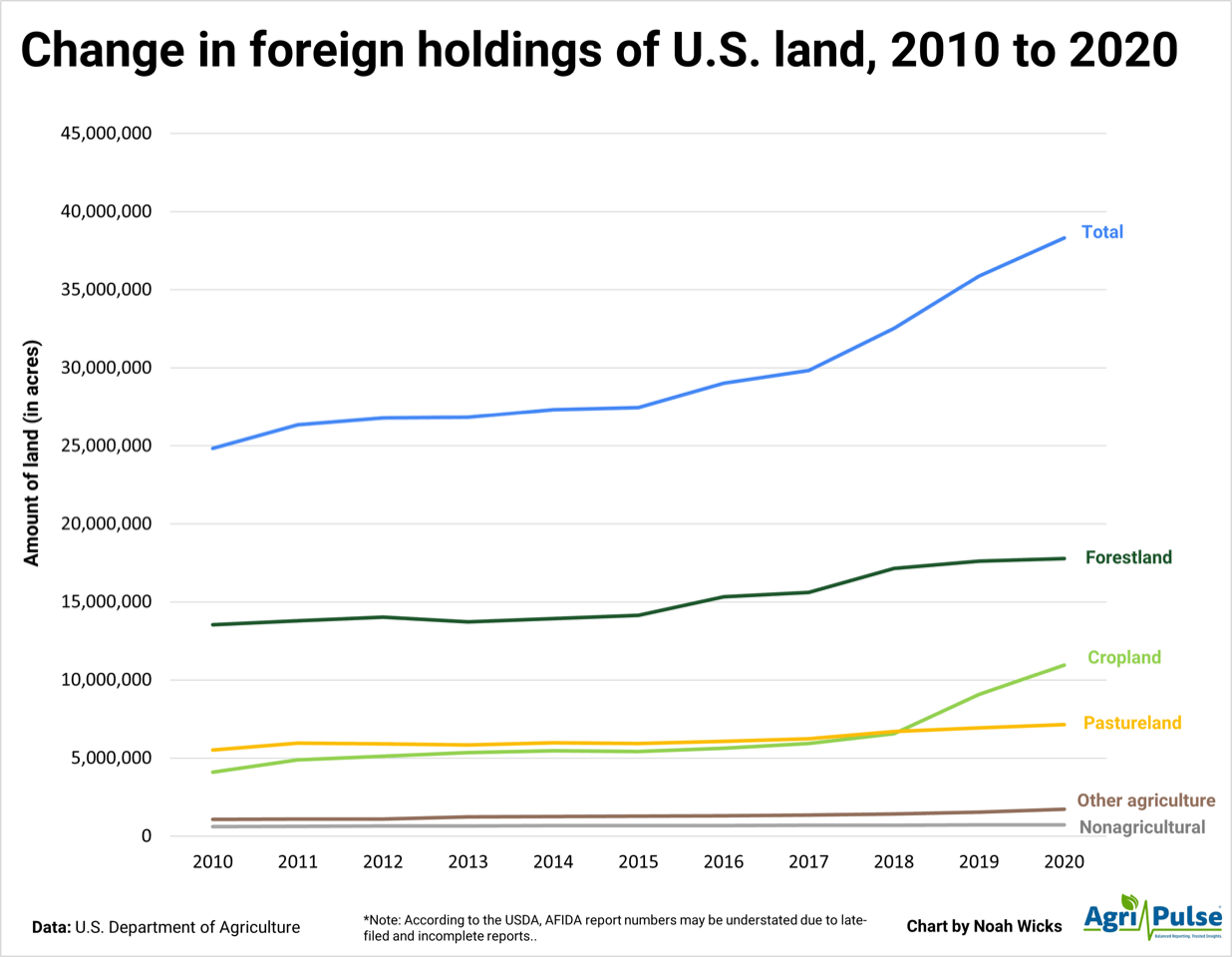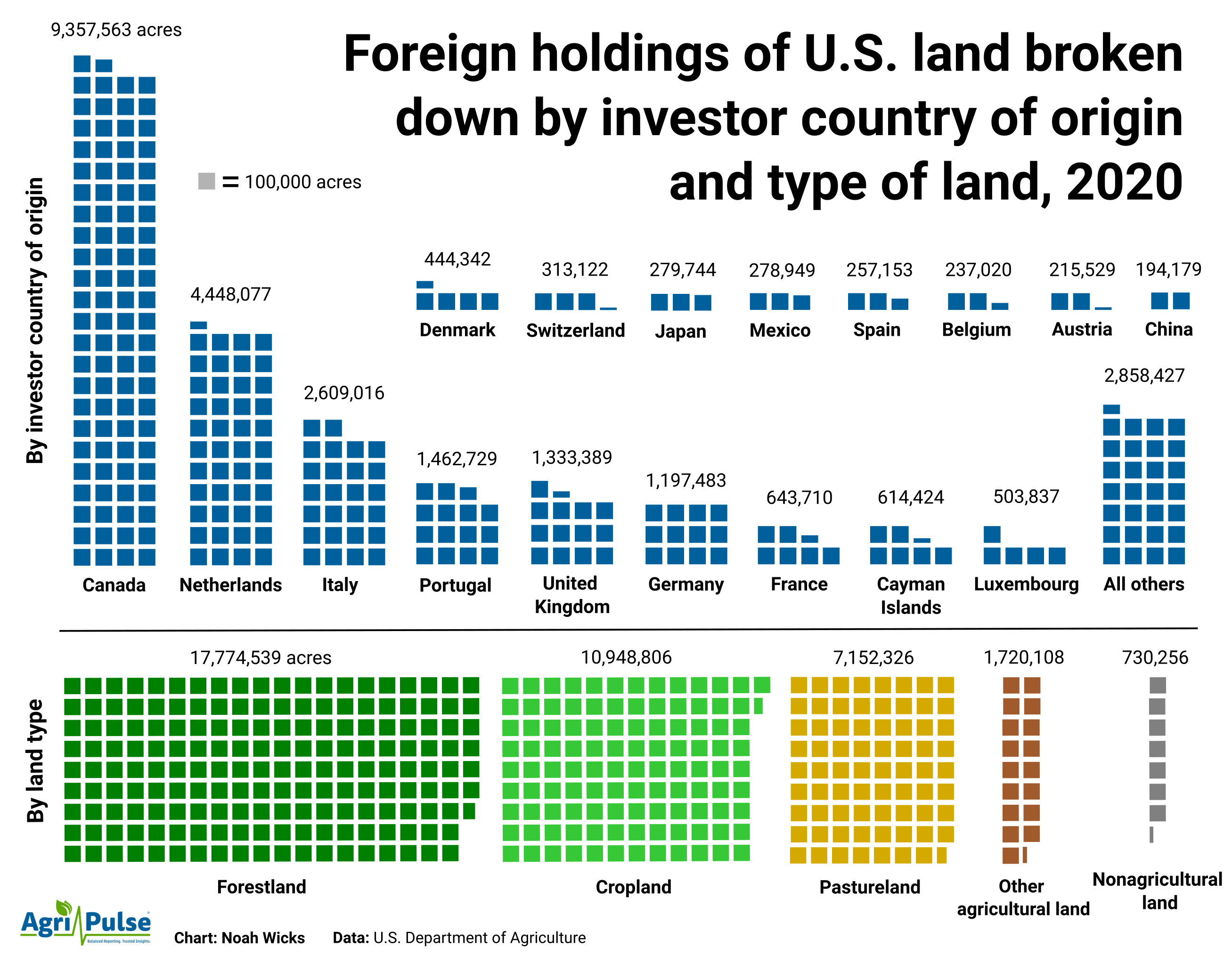International holdings of U.S. land elevated by 2.4 million acres in 2020, with 40% of the expansion occurring in simply three states — Oklahoma, Texas and Colorado — in line with a brand new Agriculture Division report. However these holdings are nonetheless a comparatively small share of U.S. farmland.
The report says 37.6 million acres, or about 2.9% of the nation’s whole farm, ranch and forest land, had been beneath overseas possession in 2020, the most recent 12 months for which knowledge was obtainable. USDA will not launch the 2021 knowledge for one more 12 months.
The report attributed a number of the development in overseas land holdings to long-term leases signed by foreign-owned wind firms on giant tracts of rangeland and cropland.
Wendong Zhang, an affiliate professor of economics at Iowa State College, mentioned extra traders — each home and worldwide — additionally selected to spend money on farmland in 2020 as a result of they noticed it as each a hedge towards inflation and as a comparatively secure funding selection.
“Inflation issues and low returns on different belongings make individuals take into consideration actual property, together with farmland,” Zhang instructed Agri-Pulse. “On the similar time, the pandemic in a way additionally pushed individuals to consider rural acreage and land, not just for crop manufacturing, but in addition for pure facilities.”
Not like Oklahoma, Texas and Colorado, some states noticed declines in overseas landholdings. Oregon noticed a 47,931-acre lower in foreign-held acres, whereas overseas traders in New Hampshire let go of three,145 acres. These declines had been both resulting from leases being terminated or the land being bought.
Below the Agricultural International Funding Disclosure Act of 1978, overseas traders are required to report their land purchases to the USDA. The company then compiles that info right into a report that’s launched yearly.
Nevertheless, the report’s authors famous that incomplete and late-filed paperwork could imply the numbers within the report are understated. In line with a 2017 article by the Midwest Heart for Investigative Reporting, the USDA largely is dependent upon firms to self-report any violations of the regulation.
Buyers from Canada, together with each entities owned totally by Canadians and by U.S. firms with Canadian shareholders, held 12.4 million acres of land, which represented 32% of all of the foreign-owned land reported by USDA. The Netherlands adopted, accounting for 13% of all foreign-held landholdings. Italy, the UK and Germany made up 7%, 6% and 5%, respectively.
Chinese language traders, whose skill to personal land is a growing concern for legislators, elevated their holdings of U.S. land from round 191,000 acres in 2019 to only over 194,000 acres in 2020. U.S. firms with Chinese language shareholders additionally noticed a bounce, going from holding over 55,000 acres in 2019 to 157,000 in 2020.
Nevertheless, even when together with the numbers reflecting U.S. firms with Chinese language shareholders, Chinese language traders nonetheless held lower than 1% of all foreign-held acres in 2020.
“International land possession by Chinese language traders is a rising and world concern, however these will increase are usually not essentially displaying up within the U.S., it is extra in all probability in Australia and Africa,” Zhang mentioned. “Naturally, given the deteriorating bilateral relations, there may be a variety of consideration, however to date, at the least, we aren’t essentially seeing these actions.”
Marijuana traders linked by some to Oklahoma development
International traders expanded their holdings of Oklahoma land by almost 383,600 acres in 2020 and now possess 1.5 million acres of land within the state. Greater than half the land is concentrated in 5 counties: Cimarron, Custer, Texas, Washita and Woods.
Roger Vaughn, an extension economist with Oklahoma State College, thinks the expansion of foreign-owned farmland in Oklahoma could possibly be tied to the state’s marijuana trade, which has grown dramatically since marijuana was first legalized in 2018.
At the least 8,850 companies are licensed to develop marijuana within the state, in line with the Oklahoma Medical Marijuana Authority. Many of those growers require land to construct their cultivation amenities, which may account for a few of this development.
“It has impacted a number of the land markets across the state the place the best and greatest use of the parcel has been sometimes in cropland or pasture, not greenhouses as at present is the case,” Vaughn mentioned in an e-mail to Agri-Pulse. “Given the potential gross market worth of the product bought, one may justify the next worth for an asset akin to land versus the anticipated earnings from ‘conventional’ manufacturing agriculture.”
Oklahoma Republican and former Home Ag Committee Chair Frank Lucas launched a invoice final 12 months that will give the agriculture secretary a spot on the Committee on International Funding in the US to observe overseas purchases of agricultural land extra intently. He additionally believes a lot of the expansion in his dwelling state is tied to marijuana operations.
“The medical marijuana enterprise has pushed these modifications relatively dramatically in the previous couple of years,” Lucas instructed Agri-Pulse. “We did not have this stage of out of doors purchases earlier than the trade, so it is introduced it to our consideration.”
Oklahoma does have legal guidelines prohibiting non-U.S. residents from proudly owning land, however these legal guidelines embody some exemptions for livestock and forestry operations. Moreover, overseas firms that aren’t fashioned beneath Oklahoma regulation are barred from proudly owning land within the state, but when these firms are fashioned beneath Oklahoma regulation, they’re freed as much as buy actual property.
The expansion of foreign-owned land in distant counties like Cimarron and Texas within the Oklahoma panhandle could also be as a result of they’re extra sparsely populated and have inexpensive cropland than different elements of the state, Vaughn mentioned.
In neighboring Texas, which has no restrictions on overseas possession of agricultural land, the quantity of land held by overseas traders elevated by 287,000 acres in 2020. Now, Texas has the most important quantity of foreign-held agricultural land in the US, with over 4.7 million acres.

Over 1.7 million acres of that land is used for forestry, whereas 1.3 million is pastureland and 1.2 million is cropland.
Charles Gilliland, a analysis economist on the Texas Actual Property Heart who makes a speciality of rural land, mentioned cropland and forestland have been latest factors of focus for home traders who need to make investments their funds in one thing tangible. He mentioned it’s doable that this development additionally extends to overseas traders, which may clarify the rise.
“Buyers have been fascinated with cropland particularly, and a few timberland, for a while now,” he instructed Agri-Pulse. “And just lately, a lot of the brokers that I talked to point that the general demand available in the market is loopy and that it may possibly’t preserve occurring like this, so there’s been various curiosity from traders.”
International traders did enhance their holdings of Texas cropland in 2020, buying 96,000 acres of that land kind in 2020. That 12 months, possession of rangeland elevated by 59,000 acres whereas holdings of forestland solely grew by round 12,000 acres.
Regardless of the expansion, nonetheless, the quantity of land held by overseas traders solely represents round 3% of the state’s general 153 million acres of personal agricultural land.
“They don’t seem to be widespread sufficient that they are getting a variety of consideration from the brokerage group at this level,” Gilliland mentioned.
Forestland makes up nearly all of foreign-owned land within the US
About 46% of all foreign-owned U.S. land, or 17.7 million acres, was used for forestry manufacturing, in line with the report.
Lloyd Irland, a school affiliate on the College of Maine College of Forest Sources and President of the Irland Group, mentioned growing overseas funding in U.S. forestland is a “ripple on a a lot greater sea.” That sea, in line with Irland, is the vertical disintegration of the U.S. forest merchandise trade and continued fragmentation of forests in areas just like the South the place populations have continued to extend.

Because the Eighties, forestland has more and more shifted from giant lumber and paper firms to institutional traders seeking to diversify their funding portfolios, in line with a 2012 Journal of Forestry article. Irland mentioned the curiosity in broadening portfolios could have performed a job within the 4.3-million-acre enhance within the quantity of forestland owned by overseas traders between 2010 and 2020.
“The asset values are pretty low volatility in comparison with widespread shares or bonds,” Irland mentioned. “Quite a lot of traders, whether or not they’re home or overseas, are very interested in that.”
4 of Maine’s northernmost counties — Aroostook, Penobscot, Piscataquis and Somerset — contained not solely probably the most foreign-owned land of any county within the U.S., but in addition probably the most forestland.
Aroostook County alone holds greater than 2 million acres of foreign-owned land and, in line with the report, greater than 1.9 million of these acres are forested. Penobscot, Piscataquis and Somerset counties observe, all holding a mixed whole of over 1.3 million acres of foreign-owned land, virtually all of which is used for forestry.
Almost 82% of the foreign-owned land in Maine, which shares its northern border with Canada, belongs to Canadian traders. It’s probably that a lot of the foreign-held acres in these counties are held by Canadian residents.
Buyers from outdoors the U.S. additionally owned hundreds of acres of forested land in counties in Michigan, Texas, Washington, Louisiana, Oregon, and Arkansas.
For extra information, go to www.Agri-Pulse.com.
















